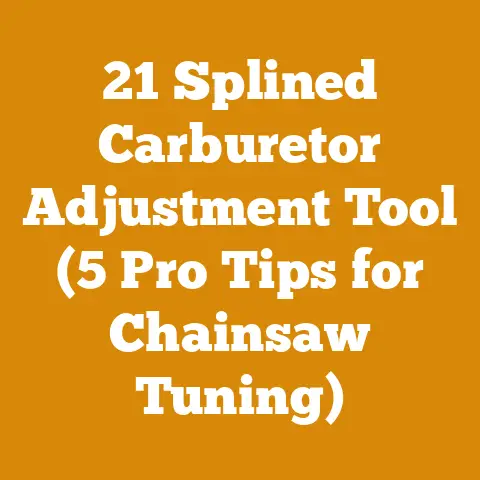Hard Hat with Ear Muffs (Top Picks for Woodcutters’ Safety Gear)
Ever felt that ringing in your ears after a long day of running a chainsaw? Or maybe you’ve taken a stray branch to the head while clearing brush? If you’re nodding, you’re probably like me – someone who understands the rewarding, yet inherently risky, nature of working with wood. That’s why a hard hat with ear muffs isn’t just an accessory; it’s a crucial piece of safety gear for anyone involved in woodcutting, logging, or firewood preparation. In this guide, I’ll share my insights on choosing the best hard hat with ear muffs, drawing from years of experience in the field and practical knowledge in wood processing.
Why You Absolutely Need a Hard Hat with Ear Muffs
Working with wood is inherently dangerous. Chainsaws, axes, falling branches, and flying debris all pose significant risks. A hard hat with ear muffs provides two essential layers of protection:
- Head Protection: Protects against impacts from falling objects like branches, tools, or even the chainsaw itself in a mishap.
- Hearing Protection: Reduces the noise level from chainsaws, wood chippers, and other loud equipment, preventing long-term hearing damage.
I can’t tell you how many times my hard hat has saved me from a nasty bump or worse. I once had a dead branch, about the size of my forearm, fall directly onto my head while I was felling a tree. Without the hard hat, I’d have been out of commission for days, possibly with a concussion. And trust me, the constant whine of a chainsaw can really take a toll on your hearing. Early on, I was stubborn and didn’t always wear hearing protection. Now, I have a slight, but permanent, ringing in my ears. Learn from my mistakes!
Understanding the Risks in Wood Processing
Before diving into hard hat specifics, let’s acknowledge the common dangers:
- Falling Objects: Branches, trees, tools dropped from heights.
- Flying Debris: Sawdust, wood chips, splinters ejected at high speed.
- Impacts: Bumping into trees, equipment, or other obstacles.
- Noise: Prolonged exposure to loud machinery, leading to hearing loss.
These risks are present whether you’re a professional logger, a weekend woodcutter preparing firewood, or even a homeowner clearing brush.
Key Terms and Concepts
Let’s define some key terms to ensure we’re all on the same page:
- Hard Hat: A rigid protective helmet designed to withstand impacts.
- Ear Muffs: Hearing protection devices that cover the entire ear to reduce noise levels.
- Noise Reduction Rating (NRR): A measurement of how well ear muffs reduce noise, measured in decibels (dB). A higher NRR indicates better protection.
- ANSI Standards: Safety standards developed by the American National Standards Institute (ANSI) for hard hats and hearing protection.
- Green Wood: Freshly cut wood with a high moisture content.
- Seasoned Wood: Wood that has been dried to reduce moisture content, making it lighter and easier to burn.
Choosing the Right Hard Hat with Ear Muffs: A Step-by-Step Guide
Selecting the right hard hat with ear muffs involves several considerations. Here’s a detailed guide to help you make an informed decision:
Step 1: Understanding ANSI Standards
The first and most crucial step is ensuring the hard hat and ear muffs meet ANSI standards. Look for the ANSI Z89.1 marking on the hard hat and the ANSI S3.19 marking on the ear muffs. These markings indicate that the equipment has been tested and certified to meet specific safety requirements.
- ANSI Z89.1 (Hard Hats): This standard specifies performance requirements for hard hats, including impact resistance, penetration resistance, and electrical insulation. There are two types (Type I and Type II) and three classes (Class G, Class E, and Class C) of hard hats.
- Type I: Protects against impacts to the top of the head.
- Type II: Protects against impacts to the top and sides of the head.
- Class G (General): Provides limited voltage protection (up to 2,200 volts).
- Class E (Electrical): Provides high-voltage protection (up to 20,000 volts).
- Class C (Conductive): Offers no electrical protection.
- ANSI S3.19 (Ear Muffs): This standard specifies the testing methods and performance requirements for hearing protection devices, including ear muffs. It focuses on the Noise Reduction Rating (NRR).
My Recommendation: For woodcutting, I recommend a Type I, Class G hard hat as a minimum. If you’re working near power lines, consider a Class E. Always check the specific requirements of your job or local regulations.
Step 2: Evaluating Noise Reduction Rating (NRR)
The NRR is a critical factor in choosing ear muffs. It indicates how much the ear muffs reduce noise levels. For woodcutting, I recommend an NRR of at least 25 dB. Chainsaws, for example, can produce noise levels of 100 dB or higher. Ear muffs with an NRR of 25 dB would reduce this to a more manageable 75 dB.
Important Note: The NRR is a theoretical value obtained in a lab setting. The actual noise reduction you experience may be lower depending on how well the ear muffs fit and how consistently you wear them.
My Experience: I’ve found that ear muffs with higher NRR ratings are generally more comfortable for extended use. They provide a greater margin of safety and reduce the risk of hearing fatigue.
Step 3: Considering Hard Hat Type and Features
Hard hats come in various styles and materials. Here are some factors to consider:
- Material: Most hard hats are made of high-density polyethylene (HDPE) or acrylonitrile butadiene styrene (ABS). HDPE is more common and offers good impact resistance. ABS is more durable and resistant to chemicals.
- Suspension System: The suspension system is the internal harness that holds the hard hat on your head. Look for a suspension system that is adjustable and comfortable. Ratchet suspensions are generally preferred as they allow for easy adjustment with one hand.
- Ventilation: Some hard hats have vents to improve airflow and reduce sweating. This can be particularly important in hot weather. However, be aware that vented hard hats may not provide adequate protection against small debris.
- Accessory Slots: Many hard hats have slots for attaching accessories such as face shields, lights, or ear muffs. Ensure that the hard hat you choose has compatible slots for the ear muffs you want to use.
- Brim: Hard hats come with either a full brim or a cap-style brim. A full brim provides better protection from sun and rain, while a cap-style brim offers better visibility.
My Preference: I personally prefer a cap-style hard hat with a ratchet suspension and accessory slots. I find it to be the most versatile and comfortable option for a variety of woodcutting tasks. I also live in a relatively wet area, so I often add a brim extension for extra rain protection.
Step 4: Examining Ear Muff Design and Comfort
Ear muffs come in several designs, including:
- Over-the-Head: The most common type, with a headband that goes over the head.
- Behind-the-Head: Designed to be worn behind the head, making them compatible with other headwear.
- Cap-Mounted: Designed to attach directly to a hard hat.
When choosing ear muffs, consider the following:
- Comfort: The ear muffs should fit snugly but not too tightly. The ear cups should completely enclose your ears without pressing uncomfortably.
- Adjustability: The headband should be adjustable to accommodate different head sizes.
- Padding: Look for ear muffs with soft, comfortable padding on the ear cups.
- Durability: The ear muffs should be made of durable materials that can withstand the rigors of woodcutting.
- Compatibility: If you’re buying separate ear muffs and a hard hat, make sure they are compatible. Cap-mounted ear muffs are the easiest option, but over-the-head or behind-the-head models can also be used with some hard hats.
My Advice: Try on different ear muffs to find the most comfortable fit. If possible, wear them for a few minutes to see how they feel after prolonged use. Consider the climate you’ll be working in. In hot weather, breathable ear cups can help prevent sweating.
Step 5: Integrating Face Shields and Other Accessories
While a hard hat with ear muffs is essential, you may also want to consider adding a face shield for additional protection. Face shields protect your eyes and face from flying debris.
Step 6: Assessing Your Budget
Hard hats with ear muffs range in price from around \$20 to \$100 or more. The price depends on the quality of the materials, the features, and the brand. While it’s tempting to save money by buying a cheap hard hat, I strongly recommend investing in a high-quality model that meets ANSI standards and provides adequate protection.
My Philosophy: Safety is not an area to cut corners. A good hard hat with ear muffs is a relatively small investment compared to the potential cost of a head injury or hearing loss.
Step 7: Considering Specific Woodcutting Tasks
The specific woodcutting tasks you’ll be performing can influence your choice of hard hat and ear muffs.
- Felling Trees: Requires a hard hat with good impact resistance and a face shield for protection against falling branches and flying debris.
- Chainsawing: Requires ear muffs with a high NRR to protect against the loud noise of the chainsaw.
- Splitting Wood: Requires a hard hat to protect against flying wood chips and a face shield to protect your eyes.
- Brush Clearing: Requires a hard hat, ear muffs, and a face shield to protect against branches, thorns, and other debris.
My Case Study: When I’m felling trees, I always wear a hard hat with integrated ear muffs and a full-face shield. I also make sure to clear the area around the tree of any obstacles that could cause me to trip or fall. When I’m splitting wood, I wear a hard hat and safety glasses, even though I’m not using a chainsaw. Wood chips can fly off the splitter with considerable force.
Top Picks for Woodcutters’ Safety Gear: My Recommendations
Based on my experience and research, here are some of my top picks for hard hats with ear muffs:
- Husqvarna ProForest Helmet System: A popular choice among professionals, this system includes a hard hat, ear muffs, and a mesh face shield. It’s comfortable, durable, and meets ANSI standards.
- Stihl Function Basic Helmet Set: Another well-regarded option, this set includes a hard hat, ear muffs, and a nylon mesh visor. It’s lightweight and affordable.
- 3M Pro-tect Professional Climbing Arborist Helmet: A more specialized option designed for arborists, this helmet offers excellent impact protection and ventilation. It’s compatible with a variety of ear muffs and face shields.
- Peltor Optime 105 Earmuff with Hard Hat Adapter: For those who prefer to customize their setup, Peltor ear muffs are known for their high NRR and comfortable fit. These can be attached to many standard hard hats with the appropriate adapter.
Disclaimer: These are just a few examples, and there are many other excellent options available. I encourage you to do your own research and choose the hard hat and ear muffs that best meet your needs and budget.
Maintaining Your Hard Hat and Ear Muffs
Proper maintenance is essential to ensure that your hard hat and ear muffs continue to provide adequate protection.
- Inspect Regularly: Before each use, inspect your hard hat and ear muffs for any signs of damage, such as cracks, dents, or tears. Replace any damaged components immediately.
- Clean Regularly: Clean your hard hat and ear muffs regularly with mild soap and water. Avoid using harsh chemicals or solvents, as they can damage the materials.
- Store Properly: Store your hard hat and ear muffs in a cool, dry place away from direct sunlight.
- Replace as Needed: Hard hats should be replaced every 5 years, even if they don’t show any signs of damage. Ear muff cushions should be replaced every 6-12 months, depending on usage.
My Tip: I keep a log of when I purchased my hard hat and ear muffs and set a reminder to replace them on schedule. It’s easy to forget how old they are, and it’s better to be safe than sorry.
Advanced Techniques for Wood Processing and Safety
Beyond the basics of hard hat and ear muff selection, there are several advanced techniques that can improve your wood processing efficiency and safety.
Felling Techniques
Proper felling techniques are essential for safe and efficient tree removal.
- Plan Your Escape Route: Before making any cuts, plan your escape route and ensure that it is clear of obstacles.
- Make a Notch Cut: The notch cut determines the direction of the fall. It should be made at a 45-degree angle, with the bottom cut slightly deeper than the top cut.
- Make a Back Cut: The back cut should be made slightly above the notch cut, leaving a hinge of wood to control the fall.
- Use Wedges: If the tree is leaning in the wrong direction, use wedges to help guide the fall.
My Experience: I’ve seen too many accidents caused by improper felling techniques. Take the time to learn the proper techniques and practice them in a safe environment. It could save your life.
Chainsaw Safety
Chainsaws are powerful tools that can be dangerous if not used properly.
- Wear Proper Safety Gear: Always wear a hard hat, ear muffs, eye protection, gloves, chaps, and boots when operating a chainsaw.
- Maintain Your Chainsaw: Keep your chainsaw clean and well-lubricated. Sharpen the chain regularly.
- Use Proper Cutting Techniques: Avoid kickback by keeping the tip of the bar away from objects.
- Be Aware of Your Surroundings: Watch out for obstacles, power lines, and other hazards.
My Recommendation: Take a chainsaw safety course. It’s the best way to learn the proper techniques and avoid accidents.
Log Splitting Techniques
Splitting wood can be physically demanding, but there are techniques that can make it easier and safer.
- Use a Hydraulic Splitter: A hydraulic splitter can significantly reduce the amount of effort required to split wood.
- Choose the Right Axe: A splitting axe with a heavy head and a long handle is ideal for splitting wood.
- Use a Splitting Maul: A splitting maul is a heavier version of an axe that is designed for splitting large rounds of wood.
- Use Wedges: Wedges can be used to split stubborn rounds of wood.
My Case Study: I used to split all my firewood by hand, but I eventually invested in a hydraulic splitter. It has made a huge difference in my productivity and has significantly reduced the strain on my body.
Wood Drying and Seasoning
Properly drying and seasoning wood is essential for efficient burning.
- Stack the Wood Properly: Stack the wood in a single row, with space between the pieces to allow for air circulation.
- Elevate the Wood: Elevate the wood off the ground to prevent moisture from wicking up into the wood.
- Cover the Wood: Cover the wood with a tarp to protect it from rain and snow.
- Allow Adequate Drying Time: Allow the wood to dry for at least 6-12 months, depending on the type of wood and the climate.
My Tip: I use a moisture meter to check the moisture content of my firewood before burning it. The ideal moisture content for firewood is 20% or less.
Strategic Advantages of Proper Safety Gear and Techniques
Investing in proper safety gear and learning advanced techniques offers several strategic advantages:
- Reduced Risk of Injury: The most obvious benefit is a reduced risk of injury. A hard hat with ear muffs can protect you from head injuries and hearing loss.
- Increased Productivity: When you feel safe and confident, you can work more efficiently.
- Reduced Downtime: Injuries can lead to downtime, which can be costly. By preventing injuries, you can minimize downtime.
- Improved Reputation: If you’re a professional woodcutter, using proper safety gear and techniques can improve your reputation and attract more clients.
- Peace of Mind: Knowing that you’re taking the necessary precautions can give you peace of mind and allow you to focus on your work.
Practical Next Steps
Ready to improve your wood processing safety and efficiency? Here are some practical next steps:
- Assess Your Needs: Evaluate the specific woodcutting tasks you’ll be performing and identify the potential hazards.
- Research and Choose Your Gear: Research different hard hats with ear muffs and choose the ones that best meet your needs and budget.
- Learn Proper Techniques: Take a chainsaw safety course and learn proper felling and splitting techniques.
- Practice Regularly: Practice your skills in a safe environment until you feel confident.
- Maintain Your Gear: Inspect and maintain your hard hat, ear muffs, and other equipment regularly.
Conclusion
Working with wood can be a rewarding experience, but it’s important to be aware of the risks involved. By investing in proper safety gear, learning advanced techniques, and following safety guidelines, you can minimize the risk of injury and enjoy the process of wood processing and firewood preparation. Remember, a hard hat with ear muffs is not just an accessory; it’s an essential piece of safety equipment that can protect you from serious injury. Stay safe, and happy woodcutting!






